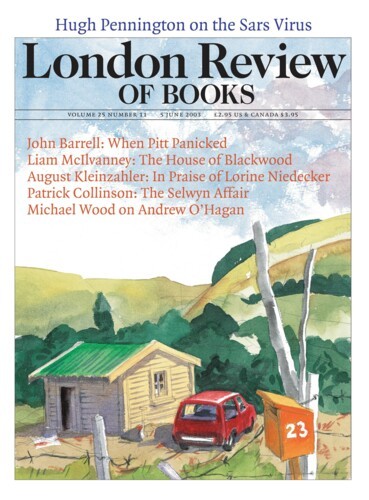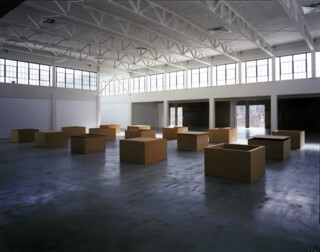The Dia Art Foundation has supported a select group of innovative artists with lavish patronage since its founding in 1974. At first, it favoured Minimalist sculptors such as Donald Judd and Dan Flavin and installation artists such as Walter de Maria and James Turrell, and certainly the early projects underwritten by Dia, from permanent exhibitions in New York City to massive earthworks in the American desert, were grand. Among the best known is The Lightning Field, a vast grid of 400 stainless-steel poles staked out by de Maria on a New Mexico plain in 1977. Dia now also oversees the mother of all earthworks, Spiral Jetty, a great coil of rocks built by Robert Smithson into the Great Salt Lake in Utah in 1970.
Initially directed by Heiner Friedrich, a German dealer who had exhibited such artists in Cologne and in New York, Dia was funded by his wife, Philippa de Menil, daughter of Dominique de Menil, a major patron and heir to the Schlumberger fortune (made from drill bits for oil wells). Along with a third collaborator, a young art historian called Helen Winkler, Friedrich and de Menil saw that this new work had opened a structural gap in the art world – neither private nor public, its scale was beyond the means of individual collectors but also outside the domain of art museums – and they created Dia to fill this gap.
During the oil crisis of the late 1970s, Schlumberger shares fell and stock had to be sold to support the operation. Eventually de Menil’s family intervened, Friedrich resigned in 1985 and Charles Wright, a young lawyer from Seattle, was hired as director. Wright continued the focus on single-artist projects and long-term exhibitions, but he also opened Dia to the art community through new shows, adventurous symposia and ambitious curators (Lynne Cooke since 1991). Most important, Wright developed the Dia building on West 22nd Street as an exhibition space (this was the birth of Chelsea as an art neighbourhood), and, with the Andy Warhol Foundation, initiated the Warhol Museum in Pittsburgh. Both these spaces were industrial structures redesigned by Richard Gluckman, who is as much an architect of the Dia aesthetic – a Modernist transparency of structure rendered with a Minimalist sensitivity to space – as any of the artists.
In 1994 Wright made way for Michael Govan, a protégé of Thomas Krens, the director of the Guggenheim Museum. By this time, Dia had acquired nearly seven hundred works, and to show this collection needed more space than the real-estate market in Manhattan would allow. From a plane above the Hudson River an appropriate structure was spotted, an old box-printing factory owned by Nabisco near a town called Beacon. Built in 1929 out of reinforced concrete, the building is a classic daylight factory shed, with great waves of skylights, vast stretches of maple floors, and the great spans between columns necessary to the expanded scale of art after Minimalism.
Dia:Beacon is only an hour from New York City, which is crucial, for Govan expects 100,000 visitors a year, lured by the art and the train ride along the river, and bringing in $7.4 million in annual revenues. This prospect convinced the State Governor, George Pataki, who lives only minutes away, to pressure Nabisco to donate the building, empty since 1991, and the state to ante up $2.7 million – though this is only a fraction of the total cost of $50 million.
The exhibition space is huge: 240,000 square feet for 24 artists (there will be temporary exhibitions as well). The formal plantings by Robert Irwin (who also did the controversial landscaping at the Getty Museum) seem precious, and the overall style of the museum, with technical devices concealed behind spare surfaces, might be called fetishistic Minimalist: its elegant austerity was expensive to produce. But the clarity of the structure and the power of the space are very impressive.
Sometimes the space overwhelms the art. At the entrance, Walter de Maria has laid out two long rows of paired circles and squares, immaculately cut in stainless steel, in two adjacent galleries of enormous length, but rather than demarcate the space they seem to dissolve into it. At other times the art overwhelms the space. Michael Heizer has cut four 22-foot steel-lined holes in various versions of cones and cubes, but its scale seems wrong, too compressed, like an earthwork beamed inside a museum, and already a clear partition protects against the inadvertent plunge. Other Dia stalwarts are not served as well as one might expect. Donald Judd is represented by a terrific set of 15 plywood boxes, all exquisitely fabricated with slightly varied tops, but it is placed towards the back. Dan Flavin is represented by a superb work, ‘Monuments’ for V. Tatlin, in which fluorescent light fixtures ring variations on the spiral form of the Constructivist Monument to the Second International (1920), but his other pieces are placed along a row of windows that compromise his distinctive effect of coloured space. Stacks of felt by Joseph Beuys and installation pieces in dirt, gravel, mirror and glass by Robert Smithson are tucked away in corners. These dead artists are not treated as well as the living. Warhol is the exception: his Shadows (1978), 72 paintings of the same gloomy image in often vibrant colours, belie the cliché that his work went to pieces after he was shot in 1968. Others who should be present are not: a house aesthetic based on Minimalism cannot easily omit Carl Andre or Robert Morris, and where is the wondrous Eva Hesse? Others don’t seem to belong here: despite the apparent novelty, the crushed car parts of John Chamberlain and the large abstract spider by Louise Bourgeois are more conventional as sculpture than other objects on view.
Several artists live up to top billing. The galleries devoted to the white monochromes of Robert Ryman allow us to see, as in a private laboratory made public, his deconstructive exploration of Modernist abstraction in process. The eight large panels of dark grey glass by Gerhard Richter are also superb: they reflect the room ambiguously, and in doing so bring his painting into dialogue with the spatial work of his Minimalist colleagues. Richard Serra’s pieces are very powerful: set in the old train depot, his three torqued ellipses and one torqued spiral activate the viewer in space like no other sculpture before or since. There are surprises, too. Known for hermetic Conceptual pieces, Hanne Darboven opens her work to everyday social life in Cultural History 1880-1983, a vast grid of representations (diagrams, photographs, postcards, magazine images) whose excess suggests the futility of any such historical record. Dia:Beacon also rescues Fred Sandback from relative obscurity: his thread pieces elegantly define the architectural frame – the span between columns, the height of ceilings and so on.
For all the diversity of the art (Fluxus, Pop, Conceptual, Minimalist, performance, site-specific), certain paradigms emerge. One is the grid, which structures not only the luminous monochromes of Agnes Martin and the colour bands of Blinky Palermo, but also Hilla and Bernd Becher’s typological photographs of outmoded industrial structures as well as Darboven’s great installation. Another model is the modular unit arrayed in an indefinite series. This order of ‘one thing after the other’ (as Judd once called it) structures the Minimalist works above all – the Judd boxes, the Flavin lights and the de Maria circles and squares – but it also governs the Richter panels, the Warhol Shadows and the little black paintings (with calendar dates in white) by On Kawara. The grid and the module antedate Minimalism, but Minimalism turned them into a basic language for art; and we also see this language shift as site-specific work comes along to pressure the architectural context: the pieces by Serra, Heizer and Sandback, but also, variously, the video corridors of Bruce Nauman, the Conceptual statements of Lawrence Weiner and the wall drawings of Sol LeWitt. Those who fall outside these three logics look out of place.
There is a catch here. Modular units can go on indefinitely, and the expanded field of art after Minimalism compelled the contemporary museum to extend beyond the usual sequence of chronological rooms. As art pushed out to engage the viewer and to frame the architecture, the spaces of the museum became as important as the walls. This installation mode is still dominant in contemporary art, and it is one reason huge museums have emerged in the form of retooled factories (like this one) and new extravaganzas (like the Guggenheim Bilbao). A funny circularity is evident here. Minimalist artists pioneered the use of Soho lofts, once used for light manufacturing, as inexpensive studios, and these spaces set the units of measurement for the work; artists like Judd and Serra also adapted principles of factory fabrication to sculpture. And now this art is being returned to an industrial setting. (To come full circle the old Nabisco box factory needs an installation of Brillo boxes by Warhol.) What is more fitting than royal portraits in palaces, paintings of modern life in national museums, abstract works in white-cube museums and Minimalist installations in industrial sheds? The problem is that it fits too well, and contradictions are plastered over in the process.
Still, the art is very intense in this setting. Long ago, Michael Fried, the brilliant enemy of Minimalism, termed such work ‘theatrical’, but the more appropriate word here might be ‘sublime’: much of this art wants to blow your mind. One hundred and fifty years ago the Hudson River School also trafficked in an American version of the sublime. Might Dia:Beacon constitute a Hudson River School II, with aesthetic contemplation reworked as perceptual intensity on an industrial scale? Often intensity seems a norm of contemporary culture – the action movies at the mall, the night bombings of Baghdad. What relation does this art have to such experiences? Does its intensity counter theirs or sublimate it? Whatever the case, the art at Dia: Beacon exists in a perpetual moment of intense experience, without the testing of prior art or social context. ‘Art has no history,’ Friedrich asserted recently; ‘there is only a continuous present.’ But such a continuous present might also become a period piece. Certainly these Giants of the Earth (the New York Times referred to these artists as ‘the Greatest Generation’) have a great triumph here. I hope it is not also their Götterdämmerung.
Send Letters To:
The Editor
London Review of Books,
28 Little Russell Street
London, WC1A 2HN
letters@lrb.co.uk
Please include name, address, and a telephone number.


